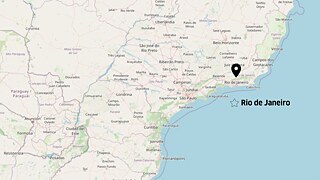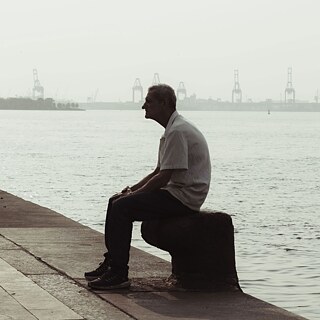Rio de Janeiro From warehouses to event locations

Marcos Lopes, known as ”Frigideira“, has lived in Rio’s harbour since childhood. He has memories of football, carnival and the heritage of ”Little Africa“ in a changing city.
I was born in 1958. I came to live here in Morro da Conceição when I was seven years old. Before that, I lived, very precariously, in Caxias, with my mother and two brothers. My father was a docker. My mother fell sick, so I came here to spend a month with my aunt. I arrived, they put me in school, vaccinated me, fed me better… So, I stayed. When I was nine years old, my mother passed away and one of my aunts adopted me. This is my world where I’ve lived for 58 years, right here in Morro da Conceição.
The harbour of Rio de Janeiro is located on the south-east coast of Brazil at the entrance to Guanabara Bay. At the foot of the Morro da Conceição hill beats the heart of Porto Maravilha, the ”marvellous port“ of Rio. | Map: OpenStreetMap.org
Carnival
My family was very festive. From festa junina, to walks, to soccer. In fact, there has been a soccer school here for twenty years. I even did a girls’ tournament in 2012 or 2013. It was a success. Something that didn’t exist in my father’s day, when I was a child. There was also Carnaval. In 1974, when I was already 15 or 16, the Conceição Band came. I helped carry ice for them, set the table for rehearsals, that kind of thing. The Band was founded on December 18, 1973. In 1974 it came out with tremendous force. That’s how it was until 1978. At the time, everyone from here was starting to enjoy Carnaval in the Lakes Region, and the band stopped playing. It ended up being a 30-year break. “Then, just like street Carnaval started to come back in, in 2008 I called up the guys and said: Let’s get the Conceição band back together?“Aside from Carnaval, people had to find a way to have fun. There were no clubs near here. It’s not far to Copacabana from here, but everything’s expensive. And the other more affordable neighborhoods were far. So, the solution for people in Morro da Conceição, who were 18 or 19 years old, was to go to Mauá Beach, to the nightclubs. There were tons of clubs. In every country, the port has that kind of draw of prostitution, ya know? In the club, we felt right at home. We knew the waiters, the owner and the bouncer. Clubs like Flórida had everything that nightclubs in Zona Sul (South Zone) had. Lights, sound… You just had to go down the hill. And there were tons of beautiful women from all over Brazil. Some of us went out with them, because we knew that afterward the ship would leave. My generation lived that, so did the generation before mine, and the one before that… I never called any of them a whore. I ended up dating one, who later got married, went to Spain and stayed there for about 20 years. We still keep in touch. They used to ask the gringos to buy beer for us, saying we were their brothers or cousins. But when times got tough for them, we were the ones paying for their beer.

Marcos Lopes in the harbour area of Rio. | Photo (deail) : © Ariel Cavotti
The nickname ‘Frigideira’ exists only once
When I was younger, around 15, my aunt wouldn’t let me go to the port. That’s what I tended to do because my dad was a docker, and my aunt was a checker. My aunt would say to me: “Don’t go down to the port because there’s lots of crooks down there.“ And there were. I’m no fool. When I say crooks, I mean it in a good way, as in a guy working to sustain his family. In there, you have an incredible amount of freedom. You got curse words here, curse words there, one guy swears, another guy swears, but all of it in harmony. I didn’t learn my street smarts there. I already knew all about it. Because Mauá Square, the prostitution area, is a school. You know more or less who you can get involved with. For example, you knew how to identify who was a dockworker by the gloves in his pocket and by his manner. Those guys were tougher. When I arrived at the port, I already knew that. I already knew where I was stepping, where to enter, who to talk to, how to talk. The crooks didn’t try to take advantage of me either, because the guys knew me, mostly because of soccer. My nickname also helped a lot, because there are fucking loads of Marcos or Polos or Johns. But there’s only one Frigideira!The birthplace of samba
Mauá Square used to be a place for prostitutes. Now you’ve got families over there in Flórida. You’ve got the museums (The Museum of Tomorrow and the Rio Art Museum). And around there you’ve got the Bhering (an abandoned factory that now houses events and workshops), and there’s also Omar’s Bar. The port area became known as ”Little Africa“, because it was where those who were enslaved arrived, and after Abolition, it remained an area that was heavily populated by black people. And it became the birthplace of samba. In recent years, that history has been reclaimed. When I was a kid, I almost never went to Pedra do Sal. Everything over there was abandoned. There were a few bars here and there owned by an old man. Nowadays, it’s all the talk. It's famous. It’s samba. And Largo da Prainha too, full of bars. It was even featured in the international press.Except, those people who spend time in the port area today have no idea what a port is. They think it’s just for cruise ships. But, they don’t know how a ship operates. I know a lot about ports, but I’ve only traveled on an ocean liner once. I was five years old. I went with my mother and my brothers to Maceió. It was a cargo ship.
Leonardo Lichote recorded the story. Thanks to Marcos Lopes, called ”Frigideira“ for sharing his harbour story and to Ariel Cavotti for the images.


